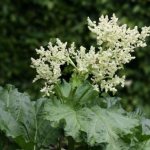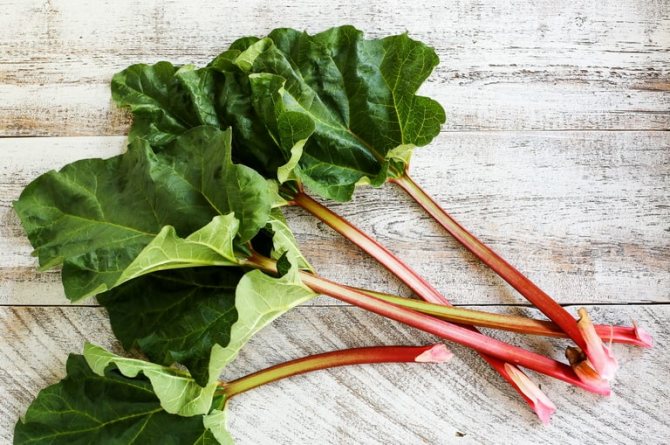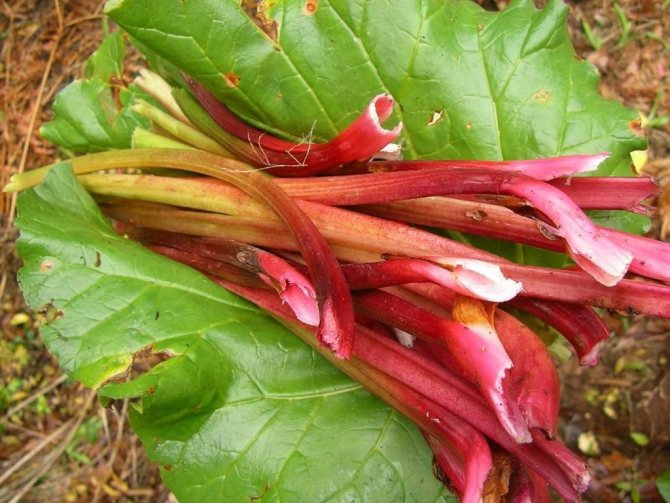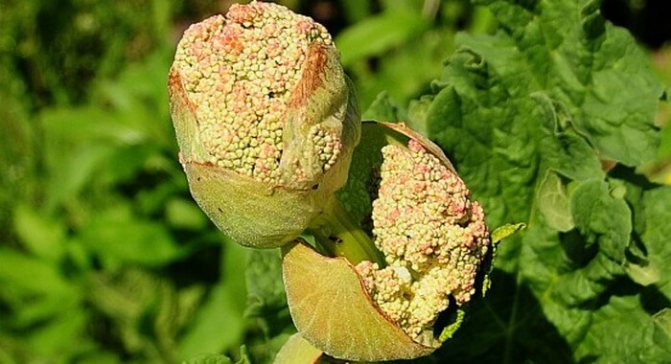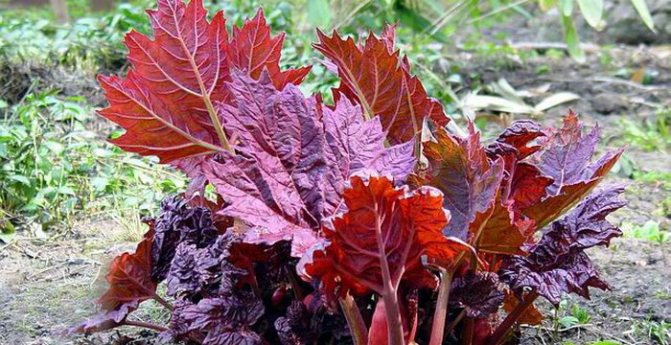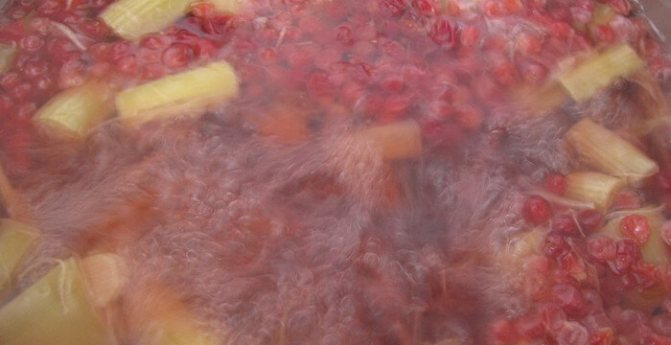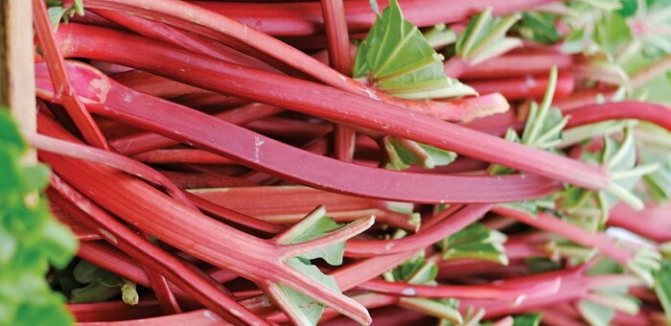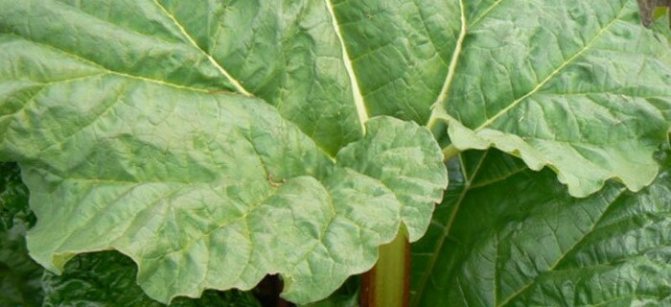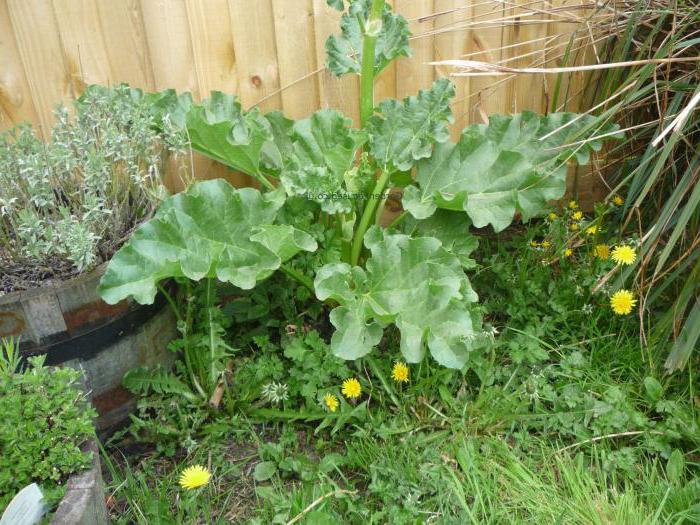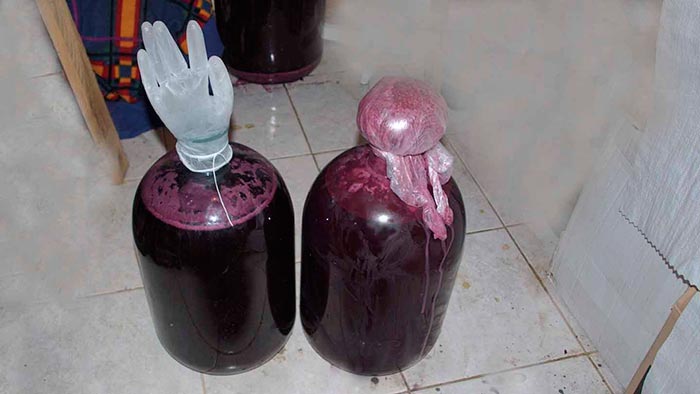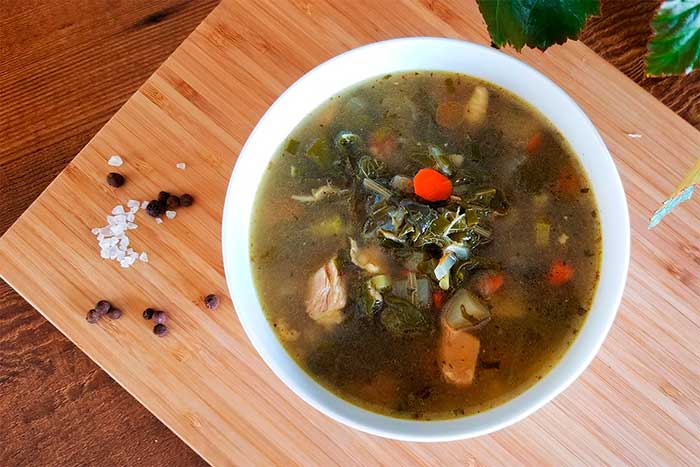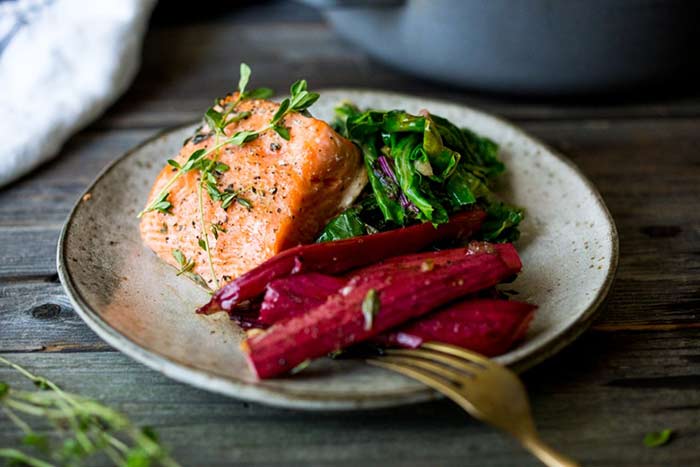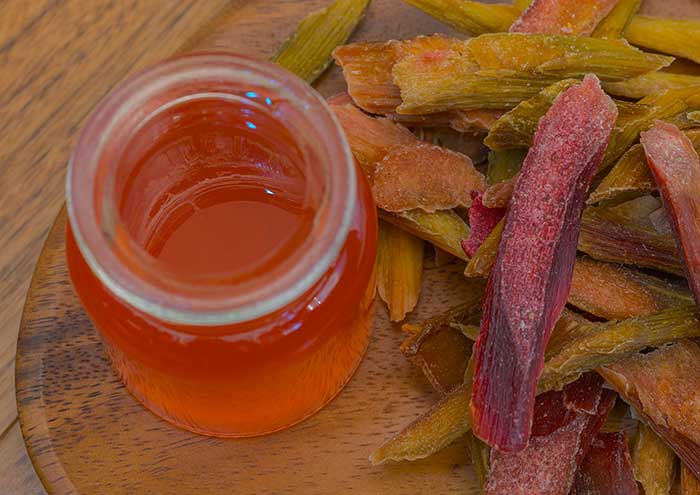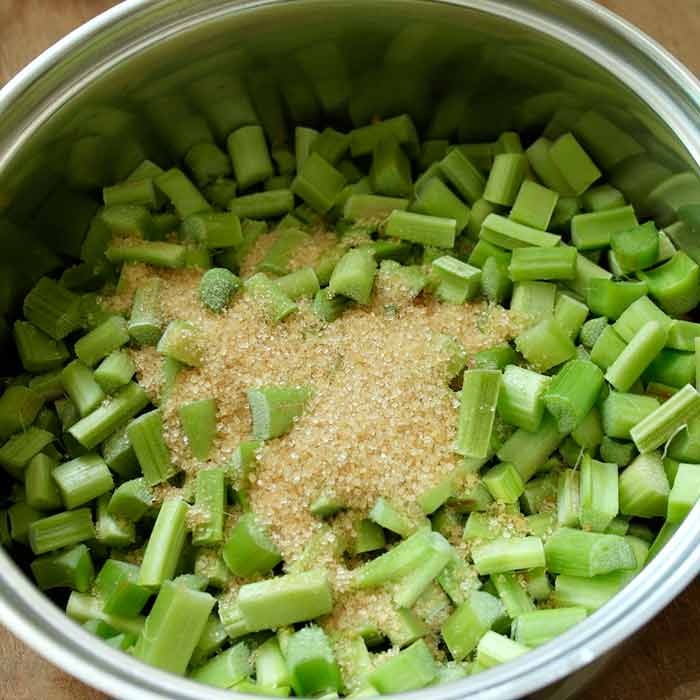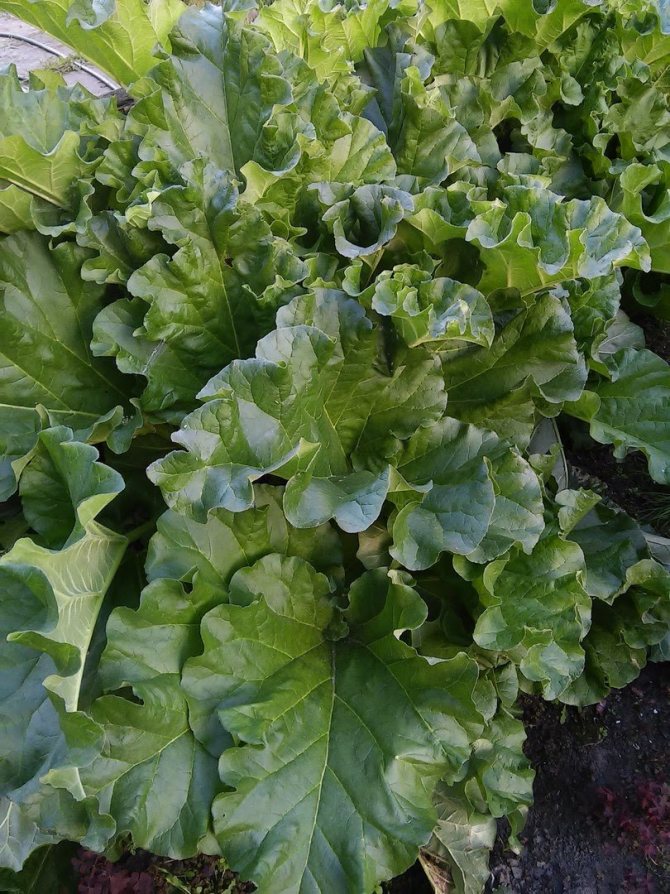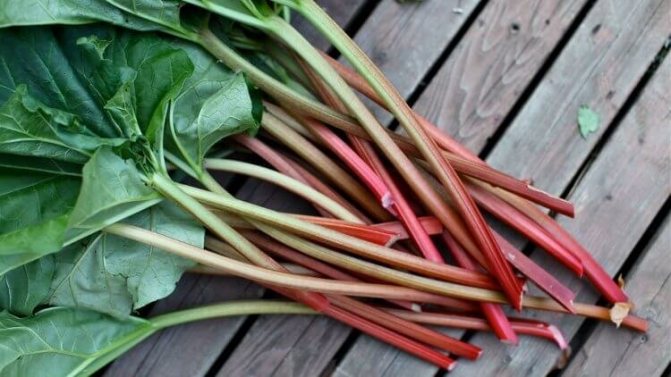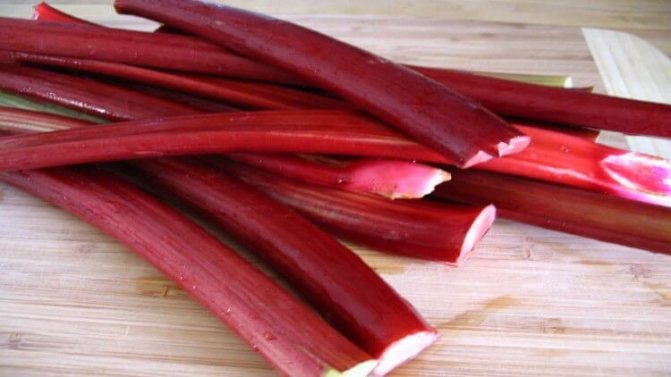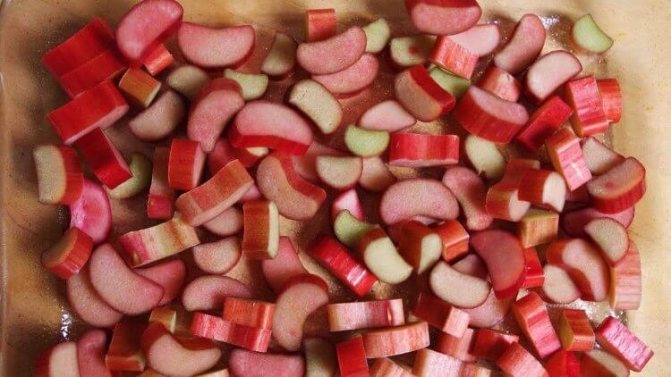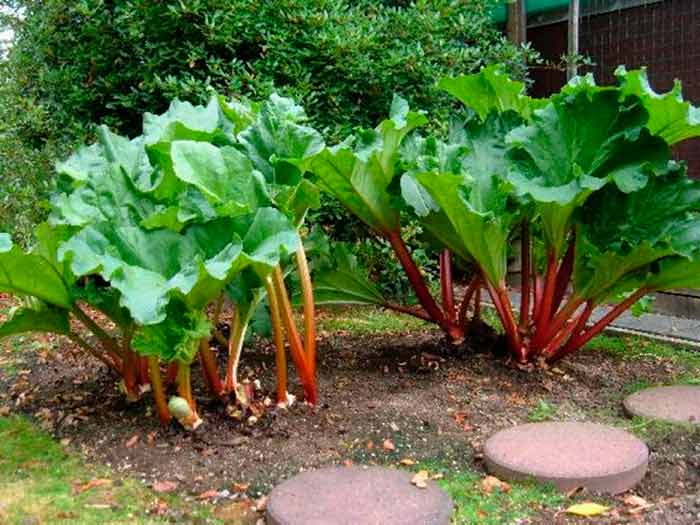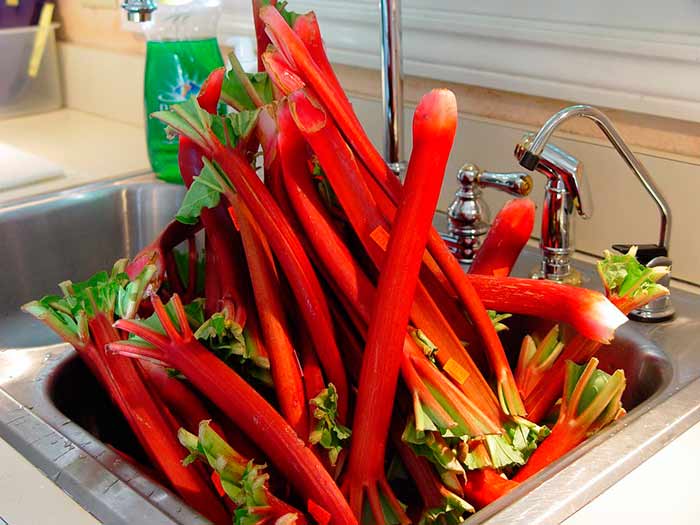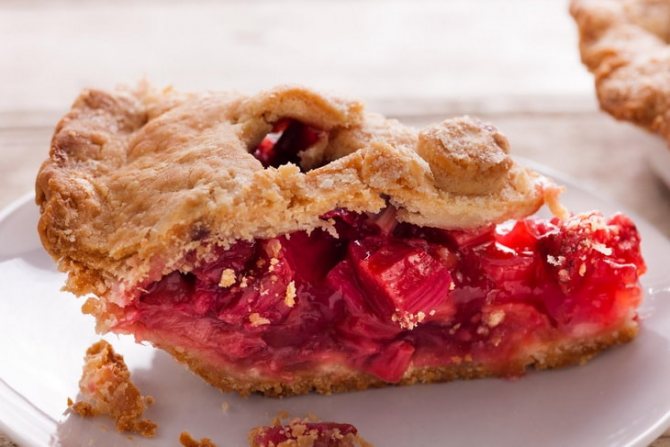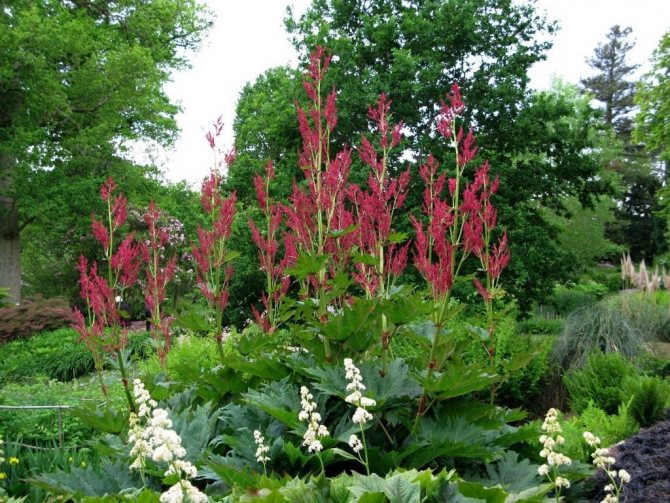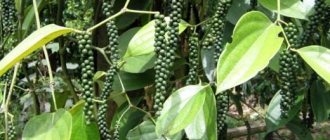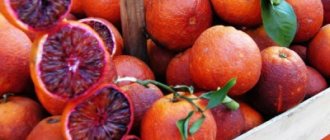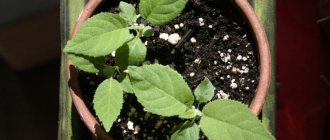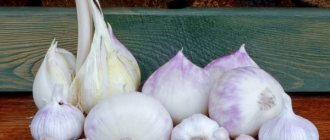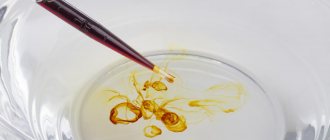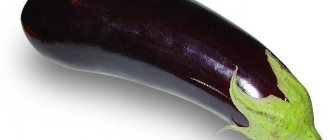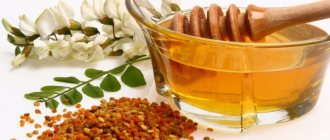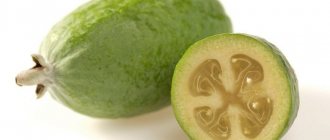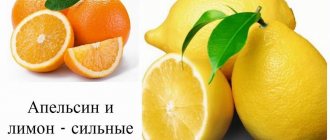What is rhubarb and what does it look like
The history of rhubarb dates back to ancient China. There healers used it for thousands of years as a medicine for diseases of the gastrointestinal tract and urinary tract, with its help they also treated skin diseases and various inflammations. In the XIII century. rhubarb was brought to Europe, where they also tried to create medicines on its basis. To repeat the success of Chinese healers did not work, however, in the 16th century. the culture has gained wide popularity due to its gastronomic properties. In the XVII century. she came to the territory of present-day Russia, where she took root well. Today this useful plant has not been forgotten and is successfully used in cooking, medicine and even landscape design.
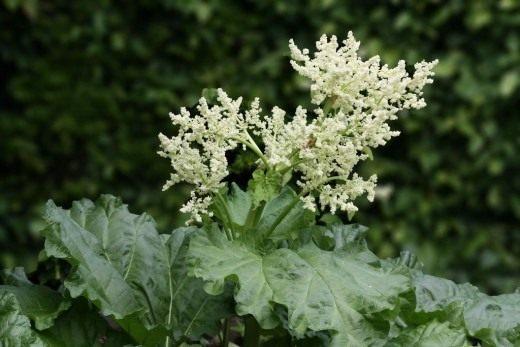
Nevertheless, many ordinary people have little idea of the external appearance of this plant, often believing that rhubarb and celery are one and the same culture. In fact, this is not the case. Rhubarb belongs to the Buckwheat family and is a perennial herb that, unlike celery, belongs to the Umbrella biennial crops. It stands out for its straight and thick stems, reaching a height of 1 - 2.5 with a diameter of 2 to 5 cm. Their surface has a rich crimson color, turning into a light green color. Each stem has 10 - 30 large fleshy leaves on long, up to 70 cm, petioles. The size of the leaf plates increases towards the base of the plant.
The flowers of the plant are excellent honey plants. Their color varies, depending on the variety, and can be white, greenish, less often pinkish or bright red. Separately, the flowers are not very remarkable, but in inflorescences that resemble shreds of sea foam, they look quite impressive. The photo above clearly shows what rhubarb looks like during flowering.
Rhubarb: is it a fruit or vegetable


Since this plant is often used in cooking for the preparation of a variety of confectionery products, it is not surprising that it is often confused with a fruit. But in reality, rhubarb can be considered a dessert vegetable, along with asparagus and artichoke.
What is the taste and smell of rhubarb
Although nominally a vegetable, rhubarb is highly regarded by desserts and fruit drink makers for its subtle sour taste, comparable to that of green apples and strawberries. This plant fully reveals its gastronomic properties in combination with sweet dishes.
The smell of rhubarb is also remarkable. It has an unusual tart scent, reminiscent of the scent of roses, interspersed with berry notes. This exotic combination has made rhubarb a popular ingredient in perfumery as well.
The benefits of rhubarb for the human body
Eating rhubarb improves gastrointestinal health, strengthens bones and prevents osteoporosis, prevents brain disease, fights free radicals, reduces inflammation in the body, relieves constipation and diarrhea, and much more. This is how rhubarb is good for the human body:
Facilitates Digestion
Since rhubarb contains a significant amount of fiber, eating it can help facilitate digestion. A study was conducted on burn patients at the Shanxi Provincial Burn Center at TISCO General Hospital in China. The researchers set out to find out how rhubarb can relieve abdominal discomfort and promote healthy and normal digestion. The study focused on relieving bloating and discomfort and improving the regularity of bowel movements.
The researchers concluded that rhubarb may help protect the intestinal wall through increased secretion of gastrointestinal hormones, while allowing normal contraction of the muscles that mix the contents of the gastrointestinal tract ().
Strengthens bones and prevents osteoporosis
The medicinal properties of rhubarb include strengthening bones and preventing osteoporosis. Since rhubarb contains a good dose of vitamin K, it can have beneficial effects on bone metabolism and prevent osteoporosis. In addition, vitamin K strengthens bones and stimulates their growth and repair ().
Research and clinical trials conducted by the University of Wisconsin-Green Bay Department of Human Biology and published in Nutrition in Clinical Practice show that vitamin K has “positive effects on bone mineral density and reduces the risk of fractures” ().
Prevents the development of brain diseases
When a person suffers from oxidative stress, it can cause numerous disorders, including stroke, Alzheimer's disease and amyotrophic lateral sclerosis, and lead to significant brain damage. Oxidative stress can lead to the formation of free radicals, which can cause neuronal apoptosis and the development of some types of chronic brain diseases.
Research published in Molecular Medicine Reports evaluated the effect of different concentrations of rhubarb extract on radiation-induced neuronal damage. Treatment with the extract significantly reduced radiation-induced inflammation in the brain, which may prove a protective role of this extract against oxidative stress (). This, in turn, could potentially help prevent brain diseases such as Alzheimer's, ALS, and stroke, among others.
Fights free radicals
Rhubarb is a highly antioxidant food similar to blueberries and cranberries. It contains the powerful flavonol quercetin, which helps slow down and stop the damaging effects of free radicals. Quercetin is a powerful antioxidant that gives plants their color.
A study conducted at the Northwest Institute of Plateau Biology Chinese Academy of Sciences in China studied rhubarb seeds. The free radical scavenging method was used as a marker to assess the overall antioxidant capacity of rhubarb extracts.Ten free radical scavengers have been isolated from rhubarb seed extracts, five of which have been identified and quantified, including epicatechin, myricetin, hyperoside, quercitrin and quercetin. All of them can be considered as the main strong antioxidants in rhubarb seeds due to their pronounced activity in cleansing the body of free radicals.
Ultimately, this study, published in the Journal of Chromatographic Science, confirms the effectiveness of rhubarb seeds in fighting free radicals ().
Relieves constipation and diarrhea
Rhubarb is often cited for its laxative properties, which are used to facilitate easy bowel movement. It is known to help relieve pain during bowel movements and in turn can relieve pain from hemorrhoids or fissures in the anal canal (anal fissures).
It is also used as a folk remedy in the treatment of gastrointestinal discomfort that occurs with constipation and diarrhea. This can be done by eating rhubarb, but it is usually done with medications such as tinctures, extracts, and powders from the roots and stems of the plant. It is imperative that you discuss these methods with your doctor, as excessive consumption can aggravate any disease (,).
However, if taken correctly, it can help reduce constipation and diarrhea naturally.
Reduces inflammation
Rhubarb has long been used in Chinese medicine for its anti-infective properties. Its consumption is known to promote healthy skin, mucous membranes, good vision and possibly protection against cancer. This is all due to its anti-inflammatory properties.
To determine the antiviral effect of rhubarb root extract, a State Key Laboratory of Virology / Institute of Medical Virology study at Wuhan University School of Medicine in China was conducted. The results, published in the American Journal of Chinese Medicine, showed that rhubarb extract showed significant positive results in the healing of inflammatory cells when added after infection, confirming its anti-inflammatory properties ().
Prevents cancer
Antioxidants have been widely studied in recent years for their ability to neutralize free radicals throughout the body. Free radicals are byproducts of cellular metabolism that can cause mutations or death in healthy cells, often leading to cancer or other chronic diseases.
Rhubarb is a good source of beta-carotene and other polyphenolic compounds () such as lutein and zeaxanthin, which act in a similar way to vitamin A to protect the skin and eyes from free radicals.
Getting enough antioxidants in your diet can help prevent premature aging, cataracts, macular degeneration, and wrinkles. Plus, these polyphenolic compounds have been linked to preventing oral and lung cancer!
Improves blood circulation
The trace amounts of copper and iron found in rhubarb are sufficient to stimulate the production of new red blood cells, increasing the total number of red blood cells in the body, as well as oxygenation in key areas of the body, thereby improving their function and increasing the overall metabolism of the body ().
Treats cardiovascular disease
Rhubarb contains very little fat and cholesterol, so its use does not pose a threat to the health of the cardiovascular system. It can actually raise good cholesterol levels due to the presence of dietary fiber, which is known to help clear excess cholesterol from the walls of blood vessels and arteries.In addition, the impressive amount of antioxidants in rhubarb ensures that free radicals do not cause heart disease and a wide range of other dangerous diseases ().
How rhubarb grows


In addition to the extraordinary taste and medicinal properties of the plant petioles shown in the photo, it is worth mentioning how rhubarb grows. It is classified as a shade-tolerant plant that does not need a lot of light, although it grows somewhat more slowly with strong shade. In the same area, the culture can grow up to 15 years, however, after 10 years of life, it begins to yield smaller volumes of harvest, therefore, after this period, the plant is recommended to be renewed.
In comparison with other vegetable crops, the main method of propagation of rhubarb in horticulture is division of the rhizome. The root system of the plant is very powerful and is able to quickly recover from damage, growing even more extensively. Seed propagation is also applicable to this crop, but not as successfully as division. The seeds of the plant sprout already at 2 ° C, but the optimum temperature for development is from 10 to 20 ° C.
Proper watering will help ensure a good crop yield. The plant prefers moderately moist soil, but grows poorly in places where groundwater runs close to the surface. Excess moisture negatively affects the state of the root system, provokes rotting. In turn, the lack of water affects the delicate texture and taste of the petioles, making them hard and bitter.
Applications
The roots and leaves of this plant are used medicinally. Pharmacies sell rhubarb extract in powder or tablet form. The herb rhubarb has long been known for its medicinal properties - antibacterial, antipyretic and choleretic.
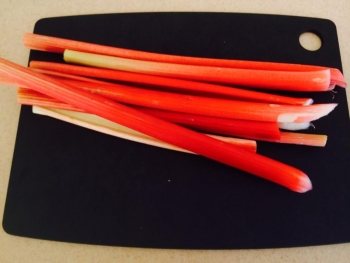

In small doses, it is useful as
a product that increases appetite and improves digestion, and in large ones it is used as a laxative.
Modern medicine does not use the antipyretic and antimicrobial properties of the plant., since more effective analogs have been found, however, recipes for tinctures and mixtures on rhubarb are popular in folk medicine to fight colds and other diseases.
This product included in many weight loss diets - it has a low energy value with a lot of useful properties.
The vegetable is not very popular as a culinary product - plant stems take a long time to prepare, rarely found in stores or in the markets. But this culture can significantly diversify your diet.
There are tons of dishes in which fleshy rhubarb stalks can be used in place of your usual foods.... It will be a salvation for those who have weakened immunity after winter or lack of vitamins. As an agricultural crop, the vegetable is unpretentious, it can be grown on your site.
What is made from rhubarb
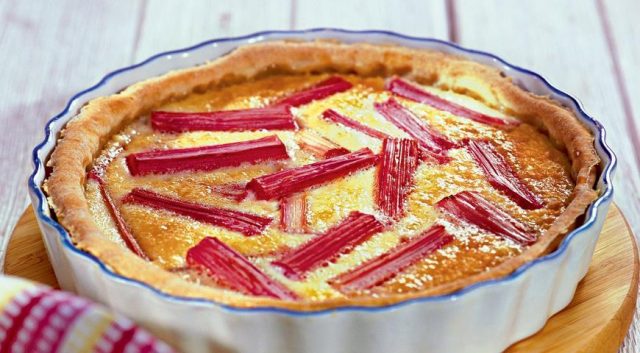

As mentioned above, the petioles of the plant have established themselves as a tasty and healthy ingredient for various kinds of desserts: from puddings and jellies to marmalade and pies. They are valued in the manufacture of seamers, preserves, jams and compotes, and for such dishes they use the most juicy petioles from 2.5 to 3 cm thick. Savory dishes such as salads, stews, vegetable purees and pickles also go well with this culture.
But the use of rhubarb is not limited to culinary alone. The laxative and anti-inflammatory properties of the medicinal varieties of the plant have found application in traditional medicine, where, based on its root, drugs are produced that help to cope with indigestion, for example, Radirex.
Rhubarb root extract has proven to be useful in cosmetology as well - as a component of various creams and face masks. He did not go unnoticed in the field of perfumery.
Summarize
- Rhubarb is a vegetable that has a sweet, tart taste, which is why it is used in the preparation of pies, jams, candied fruits and other desserts.
- Stems and flowers are the only edible parts of the plant. This is very important to know, as the leaves are actually poisonous.
- The benefits of rhubarb for the human body include facilitating digestion, strengthening bones and preventing osteoporosis, preventing brain diseases, fighting free radical damage, relieving constipation and diarrhea, reducing inflammation in the body, etc.
- Remember that you can only eat the stems (petioles) of the plant, avoiding the use of leaves, roots and rhizomes. If you are pregnant or have liver or kidney disease, you should consult your doctor before adding this vegetable to your diet.
Tags: Rhubarb
- Similar posts
- What is the difference between Iceberg salad and cabbage?
- What is endive and how is it eaten?
- Are carrots good for your eyes?
«Previous post
Rhubarb: general information
Rhubarb is a herb that botanists attribute to the buckwheat family. But even in official sources, there are references to it as a vegetable. About 20 varieties are officially registered, but in nature there are much more of them, which is explained by the high propensity for hybridity. Vegetable and medical varieties are distinguished by the shape of the leaves: in the first case, they have smooth edges, in the second, lobed or cut out.
The plant is unpretentious, common in Eurasia and the American continent. It is actively cultivated in Britain and the United States. Applications: cooking, medicine, agriculture, landscape design.
Large leaves look like burdock, they are fed to livestock, used for composting. Ripe fruit resembles a nut. From a medical point of view, the root is beneficial. Nutritional value is typical for rhubarb stalks, it is from them that sweet and sour desserts and other delights are made. The buds are also used in cooking, but rarely, as a delicacy.
The collection time is the entire warm period, but with the condition: the plant should not bloom, the buds are cut in the state of a microscopic embryo. The correct answer to the questions, what kind of rhubarb to eat, when you can eat rhubarb: year-round (in the winter in the form of candied fruits and jam). True, the taste of the stems changes depending on the season.
In early spring, they are sweetish, due to the content of malic acid, in the middle of summer, sourness is more pronounced, since the organic formula changes. Greenery lovers experiment with juiced young leaves from May to July. The roots are dug up in September. Their preparation involves several stages:
- washing;
- removal of thin "hairs" and damaged segments;
- cutting;
- drying.
Description of rhubarb
Rhubarb (Rheum) is a genus of herbaceous plants of the Buckwheat family. There are more than 20 types of rhubarb. Species of rhubarb easily give fruit-bearing hybrids, and the latter just as easily give hybrids among themselves, therefore it is difficult to obtain and identify pure species.
These are perennial very large grasses with thick, woody, branched rhizomes. Aboveground stems of rhubarb are annual, straight, thick, hollow and sometimes slightly furrowed. Basal leaves are very large, long-petiolate, whole, palmate-lobed or dentate, sometimes wavy along the edge; petioles are cylindrical or multifaceted, with large sockets at the base. Stem leaves are smaller. Rhubarb stem ends with a large paniculate inflorescence.
Rhubarb flowers are mostly white or greenish, rarely pink or blood red; they are bisexual or, due to underdevelopment, they are same-sex. The perianth is simple, six-leaved, the leaves of which are either all the same, or the outer ones are somewhat smaller than the inner ones; after pollination, the perianth withers. There are 9 stamens, in two circles, the outer circle being doubled; only for Rheum nobile Hr. six stamens, since the outer circle is not doubled.One pistil, with an upper one-celled trihedral ovary; there are three columns, with capitate-reniform or horseshoe-shaped stigmas.
The fruit of rhubarb is a triangular wide or narrow-winged nut. The seed is proteinaceous, the embryo is central.
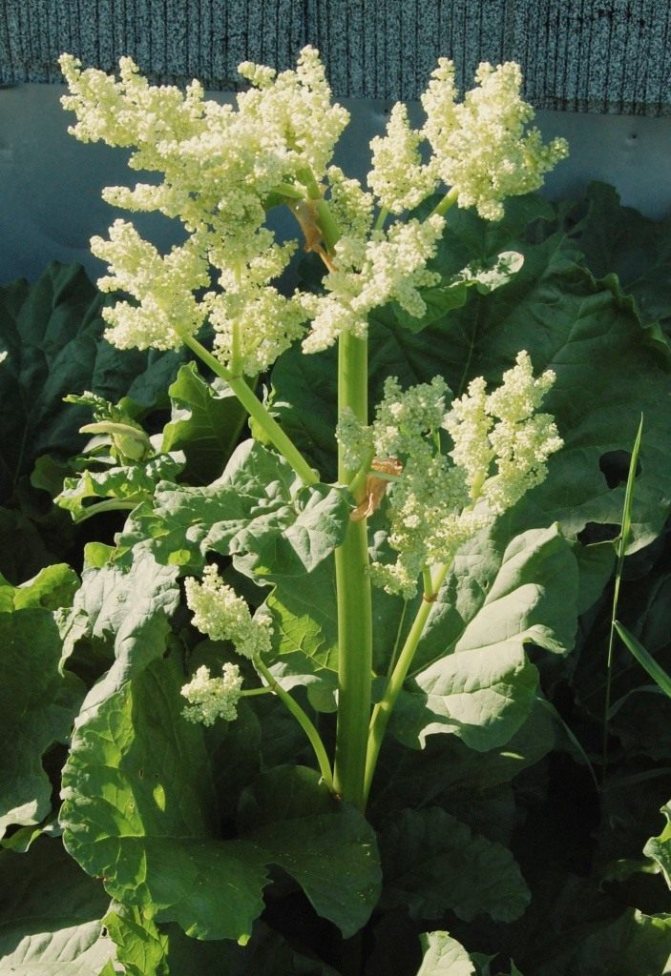

Blooming Rhubarb. <>
What are the benefits and harms of rhubarb
Let's figure out what the benefits and harms of rhubarb are. Both the tops and the roots of this wonderful plant are useful for the body. They are used in both folk and traditional medicine.
Rhubarb root contains glycosides, oxalic and chrysophonic acids, tannins, and resins. Basic properties:
- antiseptic;
- urine and choleretic;
- vasoconstrictor;
- stimulating peristalsis.
The effect on the intestines depends on the dosage of the medication. In small amounts (≤ 0.5 g) it strengthens, in significant amounts (≈ 2 g) it has a laxative effect.
The roots, ground into powder, with the addition of vinegar, honey or lemon juice, are used in home cosmetology. They are used to prepare skin-whitening masks and tonics, lotions against acne and pustules.
Physicians explain the beneficial properties of stems by the content of pectin (3.2%), vitamins of group C (at a concentration of 10 mg / 100 g), in a smaller amount of B, E, PP, organic acids (oxalic, malic, succinic). An important trace element is iron. Among the macro elements, doctors especially highlight calcium, phosphorus and magnesium. Caloric content 16-26 kcal.
Medicines and dishes containing this herbal component are recommended to increase immunity during the period with acute respiratory infections, stabilize digestion and gently cleanse the intestines, strengthen bones and vascular walls, with anemia and respiratory pathologies.
According to unverified data, drugs are prepared from the plant that help with oncology. Athletes are advised to use it to build muscle mass.
With fresh squeezed juice, the beauties wipe their face, nourishing the skin with vitamins and whitening it.
Rhubarb leaves have no medicinal properties. In cooking, they are rarely used, as an unusual filling for pies or a secret component of a salad with herbs.
Like any medicinal herb, this one has contraindications for use, namely:
- internal bleeding, including heavy menstruation;
- hemorrhoids;
- urine and gallstone disease;
- hyperacid pathologies of the stomach and intestines.
Due to the possible violent reaction of the digestive organs to pectins, the plant is not recommended for pregnant women, nursing mothers, people who are recovering after any abdominal surgery.


Rhubarb in cosmetology
The juice from the roots of the plant is often used as a kind of foundation due to its ability to give the skin a light tan. This is especially true for those who suffer from a disease such as vitiligo.


For face
Rhubarb can help even out the overall tone of the epidermis. It is enough just to lubricate the affected areas with juice from the root and leave for 10-15 minutes. Wash off with warm water. It is important to remember that after the procedure, you should not be exposed to direct sunlight for some time.
A similar effect can be achieved by combining a regular moisturizing cream and rhubarb juice in a 1: 1 ratio. Apply the mixture to the skin and rinse off after 15 minutes.
Also rhubarb is an excellent remedy for whitening freckles and age spots. To prepare a special mask you will need:
- rhubarb stalks - 2 tablespoons;
- crushed oatmeal - 1 tbsp;
- cream 15% - 1 tablespoon
All ingredients should be thoroughly mixed and the resulting mass should be applied to the skin, left for 25-30 minutes and washed off with warm water.
To heal and cleanse oily skin with a tendency to acne, you can use the following recipe:
- chopped rhubarb cuttings - 2 tablespoons;
- glycerin - 1 tbsp;
- whipped egg white - 1 pc.
Mix everything thoroughly, apply on the face and leave for 15–20 minutes. Then rinse with warm water.To achieve the desired effect, apply the mask every other day. Only 8-10 times.
Also, the plant is great in the fight against acne. You need to make a special compress by mixing chopped rhubarb rhizomes with vinegar. If necessary, this method will help with abrasions and bruises.
A tonic based on this vegetable will be very useful and nourishing for the skin of the face. You will need:
- finely chopped rhubarb roots - 3 tablespoons;
- boiling water - 0.25 l;
- honey - 1 tablespoon
Mix all the ingredients and let it brew until it cools completely, then filter. Wipe your face twice a day. The tonic is stored in the refrigerator.
Video:
6 Rescue Masks for Perfect Facial Skin Expand
For hair
The roots of the plant are used to add luster and shine to hair, as well as to lightly lighten the hair.
In the first case, you will need:
- chopped roots - 1 tablespoon;
- boiling water - 1 liter.
Pour and let it brew for half an hour. Then cool and use as a rinse after shampooing your hair.
To dye your hair you will need:
- chopped rhubarb roots - 25 g;
- cold water - 0.25 liters.
Boil the resulting mixture for 20 minutes, stirring constantly. Then cool to 35 ° C and rub into clean, dry hair. The result is a pleasant straw-yellow hue.
Another composition is suitable for the same purpose:
- chopped root - 150 g;
- white wine - 0.5 l.
Boil the mixture until half of the original volume has evaporated. After cooling, apply to hair. They will acquire a light blond shade. And if you add 0.5 tsp baking soda to the mixture, you get a dark yellow color with a reddish tint.
What to cook with rhubarb: recipes and recommendations
The easiest way to use: peel fresh young stalks and chew, dipping in sugar or honey.
What to make delicious rhubarb? The stems with a variety of additives can be used to make a wide variety of fillings for pies, rolls, muffins and other baked goods. The same product will become a piquant highlight of homemade ice cream, compote, jelly. In addition to desserts, it is added to first courses and appetizer salads.
Do not forget expand your diet and replenish the body with vitamins, such useful plants as: nettle, dandelion leaves and birch buds.
Now let's go directly to the recipes.
Rhubarb compote
This is not just a delicious drink, but also a wonderful tonic, rhubarb compote will help you quickly recover from a hangover.
Ingredients:
water - 3 l, petioles - 0.4 kg, sugar or honey - to taste.
To enhance the taste, you can add any sour or sweet berries, apples, citrus fruits, mint, ginger.
Preparation:
boil purified water with sugar or honey in a large saucepan; add stems and berries; cook for 15 minutes.
When using citrus components, they are first squeezed out, the cake is mixed with raw water. The zest is placed in the compote 3-5 minutes before cooking (as well as the mint).
Rhubarb salad
What else to cook with rhubarb? There are many variations of hearty and light rhubarb salads. Flavoring characteristics depend on the auxiliary ingredients and dressing. As the latter, you can use lemon juice and vegetable oil, honey and cream, yogurt, complex hot sauces.
We offer the simplest recipe for a spring "green" salad from rhubarb leaves. Cooking this dish takes a couple of minutes, but it quickly saturates, whetts the appetite, cleanses the intestines.
All that is required is:
Wash young leaves thoroughly, cut into strips, fill.
For those who do not have problems with weight, we recommend adding cream and sugar to the green mass (2 tablespoons per 300 g of phyto-ingredients). Gentlemen who are on a diet use lemon juice and a drop of honey for dressing, in order to somehow sweeten life.
Vegetarian rhubarb soup
Trendy rhubarb soup recipe:
boil 400-500 g of stalks cut into barrels in a liter of water (until they become soft); add the same amount of liquid; add 25 g of starch; keep on fire until thickened, stirring constantly; salt and sweeten at the same time (100 g of sugar).
To enhance the taste, you can season with cinnamon.
For those who do not like to experiment, we offer a simpler recipe.
Boil petioles, carrots, potatoes, parsley and green peas in water. Naturally, the roots must be peeled and cut beforehand. Season the vegetable stock with salt. Remove the petioles, finely chop mixed with hard-boiled eggs. Add the resulting mass + herbs to the soup a few minutes until tender.
Making rhubarb jam
Preparations such as rhubarb jam are made in early summer, until the plant is filled with oxalic acid.
Ingredients:
peeled stems and sugar in equal proportions, for example, a kilogram of both.
Preparatory stage.
Wash the stems, dry, crumble into large cubes. Put the workpiece in a plastic bowl, cover with sugar, set aside for 24 hours.
Cooking.
Pour the settled mixture into a copper bowl or tin saucepan. For lovers of thick jam and jam, we recommend adding pectin or confiture. Bring to a boil over low heat. Boil for 15 minutes. Pour into pre-pasteurized jars. It can be closed with both metal and plastic covers. Store in a basement or refrigerator.
Rhubarb recipes


In home cooking, rhubarb is commonly used for desserts and sugary drinks, but it can be used in sauces, soups, and hot dishes. Loose stalks of rhubarb need to boil for no more than a minute, fresh, freshly plucked elastic petioles must be boiled for at least 3 minutes.
Rhubarb recipes:
- Cold soup
... It takes at least 3.5 hours to prepare a meal. Rhubarb stalks (300 g) are cut into 3-4 cm pieces and boiled in salted water. The broth is set aside to cool, and when it is sufficiently cooled, put into the refrigerator. If it is very sour, add sugar. Pike perch fillet (500 g) is divided into portions and boiled until tender. Cucumbers (2 pieces) are cut, potatoes and eggs (2 pieces each) are boiled in their skins. All prepared ingredients are crushed - eggs, potatoes, cucumbers, herbs - dill, parsley, green onions are added. Lay out on plates, put fish in each of them, pour in cooled rhubarb broth. - Meat with rhubarb sauce
... It is advisable to cook pork, but this sauce also goes well with beef and poultry. Pour half a glass of red dry wine into a saucepan, season with ginger and add mustard powder - 1 tablespoon of spices each. Simmer for 1-3 minutes. Meat (500 g) is cut into portions, marinated for 30 minutes, then baked in the oven in a sleeve or in the microwave. Rhubarb stalks (200 g) are halved, one part is cut into small pieces of 0.5 cm, and the second is larger. Coarse slices are poured with water (2/3 cup), covered with sugar (100 g) and placed in the microwave for 6 minutes. When the mass becomes homogeneous, it is rubbed through a sieve. Small pieces of the plant are added to rhubarb puree and put back in the microwave for 3 minutes. Remove from the microwave and add finely chopped parsley. Pork is laid out on a dish, poured over with sauce. It is better to use rice as a side dish. - Rhubarb pie
... The dough is kneaded quickly, so you should turn on the oven from the very beginning, so that it has time to warm up to 180 degrees. A baking sheet with high sides is covered with parchment and greased with oil. Combine a glass of flour with half a glass of sugar, add half a pack of butter and knead a not very tough dough, separate it a little for decoration. The dough is spread on a baking sheet and baked for 15 minutes, you do not need to bring it to full readiness.While the base of the pie is baking, prepare the filling - mix 2 chopped boiled eggs, a glass of sugar, 2 cups chopped rhubarb stalks, 4 tablespoons of flour and a little salt. The filling is carefully laid out on the base, strips are formed, which decorate the top of the pie, and baked until fully cooked - 40-45 minutes. Sprinkle with icing sugar before serving. - Salad
... Ingredients for vegetable salad: rhubarb - 300 g, several cauliflower inflorescences, half a bunch of parsley, 3 boiled eggs, juice of half a small lemon, a third of a glass of unsweetened yogurt, olive oil, mayonnaise - 1.5 tablespoons each, curry powder - half a teaspoon spoons, a little black pepper. Cauliflower is boiled for no more than 1 minute, cut, rhubarb is cut into small pieces and used raw. All other ingredients are also crushed. The dressing is prepared separately by combining yogurt, olive oil, mayonnaise, salt, pepper, curry powder. Pour vegetables with dressing and put in the refrigerator for 15 minutes, brew. - American compote
... Americans believe that rhubarb tastes perfect with strawberries, and they often combine the two. The zest is removed from the orange and the juice is squeezed out. Water is poured into a saucepan - 1 liter, 2 tablespoons of honey, orange juice, zest, sugar to taste are added, boiled for 5-7 minutes. Tough fibers are removed from the stalks of rhubarb, cut into small pieces, dipped in a boiling liquid, brought to a boil and removed from heat. When it has completely cooled down, put the container on low heat again, add strawberries. If the berries are frozen, you do not need to defrost them. As soon as the liquid boils, the pan is again removed from the heat and cooled, first at room temperature, and then in the refrigerator. Place two fresh chopped strawberries in each cup before serving. It goes well with ice cream. In this case, you need to cook the compote thicker so that it resembles syrup in consistency. - Jam
... Rhubarb in jam goes well with regular red rowan. It is advisable to pick berries away from country roads. Rhubarb stalks are cut into pieces, mixed with mountain ash - the proportion of ingredients is 1/1. Syrup is made from sugar - it should be twice as much by weight as a mixture of ingredients for jam, filled with water. The proportions of sugar and water are 1 kg / 1 glass. Rhubarb with mountain ash is poured with syrup, boiled for 1-1.2 hours, removing the foam. Then everything is crushed with a blender to a uniform consistency, brought to a boil, laid out in sterilized jars and the lids are rolled up. The jam will turn out to be liquid, it will thicken already in jars, after 2 months of storage.
The amount of oxalic acid in the petioles depends on the condition of the plant. The most sour taste in oppressed, undersized thickets. Petioles from powerful bushes are sweeter, more gentle on the mucous membrane of the digestive tract and are more suitable for making desserts. In healthy bushes, you can use young leaves for food - add them to salads.
What is good for health
Proven that eating this product has a positive effect on metabolism, like cilantro, improves appetite, restores the normal functioning of the digestive tract... The plant contains substances that strengthen the immune system.
There are rhubarb stalks
the most useful organic acids: apple, lemon, amber and oxalic. The stem of the plant is rich in B vitamins, contains vitamins P, A, C, E and a lot of carotene.
Eating rhubarb is good for people who have liver problems. This plant is an excellent choleretic agent due to the presence in it a large amount of mineral salts and kakhetins (antioxidants).
Found in this product a significant amount of pectins (polysaccharides), rutin and a mass of trace elements, including iron, phosphorus, calcium, magnesium (learn about foods containing potassium and magnesium).Recent studies have also revealed the substance chrysarobin, which helps to fight the external manifestations of psoriasis, has a beneficial effect on the skin and hair.
The use of rhubarb in food has restorative action... This is a good remedy for the recovery of the body after a long-term lack of vitamins or a protracted illness. It has been proven that the use of this product can significantly reduce the risk of benign tumors due to the polyphenols present in it.
Biologically active elements contained in the petioles have a positive effect on the work of the circulatory system, strengthen the heart muscle, reducing the likelihood of a heart attack. The stems of this culture are very useful for children., since the high content of vitamins A and C has a beneficial effect on vision and the musculoskeletal system.
A good dietary product with a low energy value - only 26 kcal per 100 g. It is preferable to eat a vegetable during the season when the amount of nutrients it contains reaches its peak.
Composition and calorie content of rhubarb
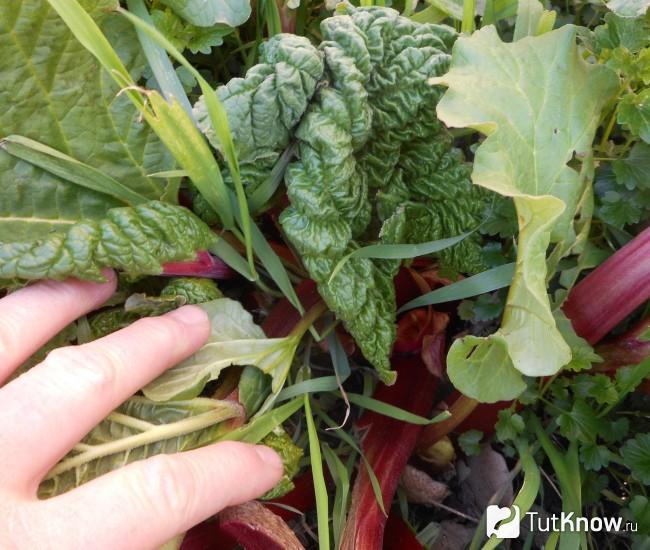

Fresh rhubarb - petioles and very young leaves have nutritional properties. In dried form and in a mature plant, the qualities change.
The calorie content of rhubarb per 100 g is 16 kcal, of which:
- Proteins - 0.7 g;
- Fat - 0.1 g;
- Carbohydrates - 2.5 g;
- Dietary fiber - 3.2 g;
- Water - 91.5 g;
- Ash - 1 g.
Despite the fact that the leaves and petioles of the plant are practically not used as medical raw materials, they contain a rich complex of useful substances.
Vitamins per 100 g:
- Vitamin A, RE - 10 μg;
- Beta Carotene - 0.06 mg;
- Vitamin B1, thiamine - 0.01 mg;
- Vitamin B2, riboflavin - 0.06 mg;
- Vitamin B5, pantothenic acid - 0.08 mg;
- Vitamin B6, pyridoxine - 0.04 mg;
- Vitamin B9, folate - 15 mcg;
- Vitamin C, ascorbic acid - 10 mg;
- Vitamin E, alpha tocopherol, TE - 0.2 mg;
- Vitamin PP, NE - 0.2 mg;
- Niacin - 0.1 mg
Macronutrients per 100 g:
- Potassium, K - 325 mg;
- Calcium, Ca - 44 mg;
- Magnesium, Mg - 17 mg;
- Sodium, Na - 2 mg;
- Phosphorus, Ph - 25 mg.
Trace element - iron, Fe - 0.6 mg.
Digestible carbohydrates per 100 g:
- Starch and dextrins - 0.2 g;
- Mono- and disaccharides - 2.3 g.
The following nutrients in the composition of rhubarb provide a beneficial effect on the body:
- Vitamin A - stabilizes the immune status, normalizes reproductive function, increases regenerative properties, improves the quality of skin, hair and improves visual function.
- Vitamin C - normalizes redox processes, improves the functioning of the immune system, helps to absorb iron, increases the elasticity of the capillary walls.
- Vitamin B9 - this coenzyme (non-proteinaceous molecule) takes an active part in the metabolic process of nucleic substances and amino acids. Deficiency of vitamin B9 (folic acid) during pregnancy leads to impaired fetal formation, to the appearance of physiological abnormalities.
- Potassium - this substance is the main intracellular ion, which is actively involved in the normalization of water-electrolyte and acid-base balance, normalizes the functions of the nervous system and maintains blood pressure.
- Calcium is responsible for muscle function and the quality of bone structure.
The taste of rhubarb stalks is provided by the acids included in its composition: ascorbic, oxalic, malic. Therefore, one should not be surprised at the pronounced acidity when consumed.
In what form is it better to use
Rhubarb is a vegetable, but it is used as a fruit in cooking. It cannot be eaten raw. The stems of the plant, like sorrel, contain a lot of oxalic acid, which is neutralized during cooking. But it will still not work raw to eat it - fresh stalks are very sour, leaving an unpleasant "silk" plaque on the teeth.
It is used as a filling for a sweet pie, compote is made from it, rhubarb jam is popular in many countries. The dishes from this product are rich in English cuisine - besides confectionery, the vegetable is used in sauces and even used as a side dish for meat.
Before cooking petioles are thoroughly peeled - it contains the most oxalic acid. The stems are crushed and boiled in sugar syrup, then the mixture is ground - the confectionery filling is ready. It tastes very much like applesauce. Rhubarb baked goods are very juicy and aromatic.
This vegetable do not overheat... With prolonged exposure to high temperatures, rhubarb releases large amounts of oxalic acid and potassium, which react with each other to form potassium salts. They accumulate in the body with salt deposits.
Rhubarb is available in several varieties. The sourest of them all is green. It is tough, with a thickened skin - it takes longer to cook.
Least of all oxalic acid in red - it is the most common, takes less time to cook, has a raspberry flavor.
Rhubarb story
It is said that the scientific name of the genus (Rheum) comes from "Ra" (Rha), the ancient name of the Volga River, where the rhubarb plant grows. The Chinese first used this plant in medicine thousands of years ago. It is known that rhubarb in the 17th century in England was used for food purposes. At the time, sugar was only available to wealthy people, so the sweet rhubarb tarts were pretty enjoyable. Marco Polo, a famous Venetian traveler and merchant, was a big fan of this vegetable, as a result of which he shared his knowledge of the rhubarb rhizome in his stories ().
Rhubarb is most commonly found in farmers' markets and grocery stores in a stalk like celery. Spring is the best time to harvest rhubarb, usually from April to June. The stems are easily recognizable by their bright pink color and are also found in light pinks and pale greens, which have nothing to do with maturity or sweetness. However, the stems and flowers are the only edible parts of the plant. This is very important to know, as the leaves are actually poisonous.
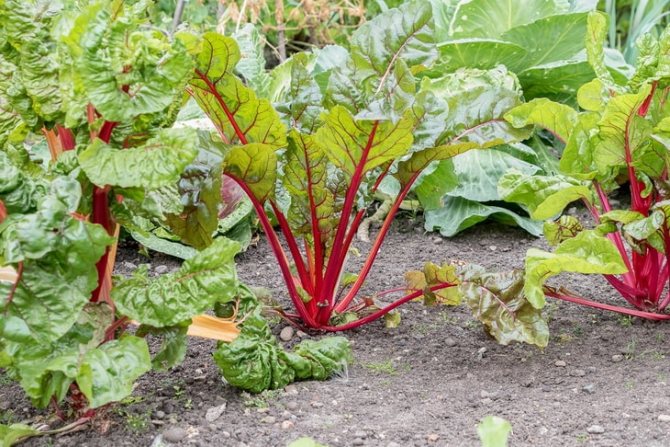

Potential danger and how to avoid it
Although rhubarb has many beneficial properties, some are advised to use it less often or even refuse it altogether if there are contraindications.
Contraindications
The plant is highly acidic. Rhubarb contraindicated in people with serious diseases of the gastrointestinal tract... This is especially true for those who have a tendency to internal bleeding and ulcers.
Product should not be eaten by people with acute inflammatory processes in the kidneys and bladder, urolithiasis or hemorrhoids.
Doctors recommend exclude it from the diet of patients suffering from diarrhea, diabetes mellitus, cholecystitis... It also should not be eaten with gout.
Allergy
Rhubarb - hypoallergenic plant... But cases of allergy to it in medicine were recorded, although very rarely.
Its greenish-red stems have become a real salvation for those who are allergic to strawberries or apples - after all, for example, rhubarb pie tastes like apple or strawberry. therefore the danger of the product for allergy sufferers is negligible.
Is it harmful to pregnant women and children
On the use of rhubarb in food for pregnant women the opinions of doctors are somewhat divided... Some believe that it is better to exclude this product, while others, on the contrary, advise using it regularly.
Their opinions agree on one thing - too often during pregnancy it is not worth eating... The reason is high acidity.
As stated above, rhubarb is useful for children because of its high content of vitamins and beneficial microelements... If the child has no contraindications (these are gastrointestinal diseases, diabetes mellitus), then this vegetable will only benefit him. The product can even be given to children under three years old in the form of compotes or sweet puree.
For more on the health benefits and potential health risks of rhubarb, watch this video:
Harm and contraindications
Rhubarb, possessing a whole range of beneficial effects, acts like a drug, which means it cannot be consumed uncontrollably. Leaves (petioles) of rhubarb are not recommended for people with kidney stones - because of the deposition of scale salts.
Rhubarb is also contraindicated for:
- individual intolerance;
- stones in the gallbladder;
- peritonitis;
- rheumatism;
- cholecystitis;
- pancreatitis;
- inflammation of the genitourinary system;
- diabetes mellitus;
- gastric and hemorrhoidal bleeding.
Rhubarb should be used with caution when:
- increased acidity;
- stomach ulcer;
- cirrhosis of the liver.
It is not recommended to use petioles and dishes / preparations made from them for diarrhea. In this state, rhubarb can have a stimulating effect - there is a risk of dehydration.


Rhubarb: varieties (most popular)
Today there are more than a hundred varieties of this plant, but not all of them are widespread in Russia.
- The Victoria variety is one of the earliest and most productive. It has a great taste. The length of the petioles does not exceed 60 centimeters. According to gardeners, the Victoria variety has a drawback - too abundant flowering.
- Moskovsky-42 is one of the earliest varieties with a high yield and excellent taste. The petioles are seventy centimeters long and more than three centimeters thick. The petioles are smooth, green in color and have a red stripe at the base.


- Ogre-13 is a high-yielding mid-season variety. It develops well and forms petioles in the shade. The flesh of the thick and long petioles is very tender and juicy. Two generative shoots are formed on the plant.
- Large petiolate is a very early variety that forms a powerful rosette of leaves, with dark red petioles. Their length is no more than 60 cm and a width of 2.5 cm. They have a pleasant taste and tender flesh.
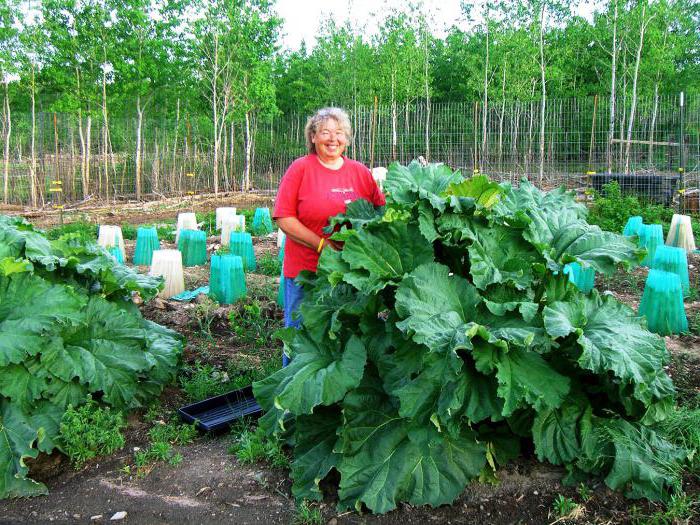

- Giant - this variety belongs to the late ones, which pleases with the harvest, when the early varieties have already bloomed and hardened. The petioles are huge, up to one meter long and up to four centimeters thick, red.
When to harvest and store rhubarb
Since it is a perennial plant, harvesting takes place in two stages. At the first stage, the leaves are collected, and during the second (possibly in a few years), the roots are dug out.
The roots can be dug up after the plant is four years old. After that, they are washed, cut into small pieces and dried, first in the open air, then in dryers at a temperature of 60 degrees. Petioles are plucked gradually, three to four times per season. It is customary to finish harvesting at the end of July so that the plant can gain strength by next year.


There are several ways to harvest rhubarb for the winter:
- as homemade preparations - jam or compotes;
- by freezing;
- leaving the dried roots in a cool, dark, ventilated place.
You can freeze a vegetable with or without a skin. For compotes, the option with the skin is also suitable, and if you plan to use the plant as a filling for pies or for salad, it is better to remove the skin. You can freeze both as part of a salad mixture, and separately washed plant.
Can be frozen in sugar: the peeled and washed vegetable is cut into pieces and placed in a food container in layers separated by sugar. A kilogram of petioles will require about one and a half to two glasses of sugar.


Can rhubarb be given to children
Since rhubarb contains some types of acids (for example, oxalic), it can be dangerous to eat it in some cases. Therefore, in the first years of a child's life, it is better not to feed him with this vegetable.
Important! Talk to your doctor before giving rhubarb to a young child.
At what age children can rhubarb
After the child reaches the age of one and a half years, you can - with the permission of the pediatrician - use the plant as a medicine.
As a food product, it can be consumed starting from about two to three years (earlier - only with the permission of a doctor and for medicinal purposes). The vegetable must necessarily undergo heat treatment: you can carefully give the child rhubarb jam or compote.
How to cook rhubarb for your baby
It is recommended to make compote for the first time. Rhubarb compote for children is made as follows: peel the stems, squeeze the juice out of them. Then boiled hot water mixed with fruit juice is added to the juice to improve the taste of the drink. Introduce into the diet, gradually increasing the dose, while the first time you need to give very little.
When the child grows up, it will be possible to give him regular meals containing this vegetable.
Types of rhubarb
Nowadays, in kitchen gardens and orchards, both cultivated varietal forms of plants and wild, species are found. The latter are attractive for decorativeness, unpretentiousness in care.
- Medicinal rhubarb. It is distinguished by its enormous size: the leaves of the plant reach one and a half meters in length, and the peduncles exceed human growth.
- Noble rhubarb. The plant forms a tall "ear", consisting of large corrugated leaf plates.
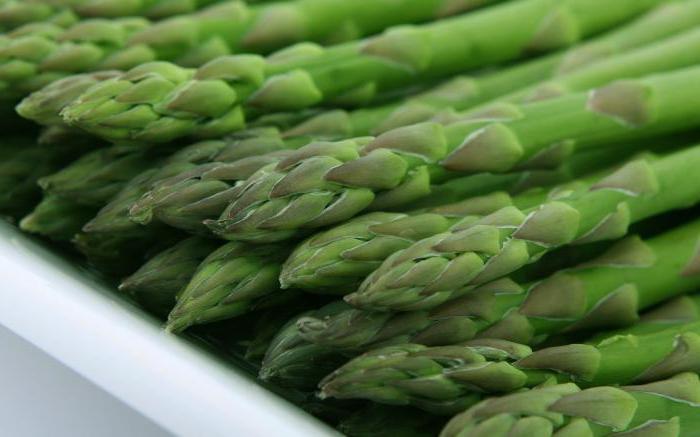

- Finger rhubarb. Its second name is Tangug. This species is interesting for its strongly dissected bright leaves and crimson flowers, which are crowned with tall peduncles.
- Vegetable rhubarb. This species is recommended as a garden plant. Cultivated varieties of this species have juicy and thick stalks, with a pleasant taste, and they do not coarse for a long time.
Diseases and pests of rhubarb
Rhubarb is very rarely affected by disease, but if you act on the "plant and forget" principle, the plant will become vulnerable to infection and insect pests. Of course, a lot also depends on climatic conditions. Excessive moisture, high - up to 28 ° C - temperature and its sharp drops, too much nitrogen in the soil structure, thickened plantings - favorable conditions for the development of diseases and pests.
Rhubarb disease
Most often, gardeners have to deal with rhubarb diseases such as ascochitis, white spot (ramulariasis), powdery mildew and rust. While ascochitis and ramulariasis are more common in the Central and Arctic regions, the latter are common on rhubarb leaves in the southern regions.
Ramulariasis
In ramulariasis, rhubarb foliage is covered with brown spots with a darker border. Over time, the spots grow and merge into one whole. The middle of the leaves gradually brightens. With high humidity, the disease progresses, and huge leaves are covered with a white or silvery coating. If the climate is dry, the tissue of the leaf blade cracks and gets into the soil.


In ramulariasis, rhubarb leaves are covered with brown spots with a darker border.
Ascochitosis
Ascochitosis refers to fungal diseases of rhubarb, it affects both the rhizome and the stem with leaves. The roots turn black and die off, weakening the plant. Small hot yellow spots first appear on the leaves, which later turn brown or dark gray with a brown border and elongate, taking an irregular shape. The leaves, as with ramulariasis, begin to crumble, fall off. On them you can see black dots - pycnidia, which contain spores of the pathogen-fungus. Sometimes the disease spreads to the stems. In their basal base, spots of a whitish-gray hue appear, along which dark points of the fruit bodies of harmful fungi are scattered.
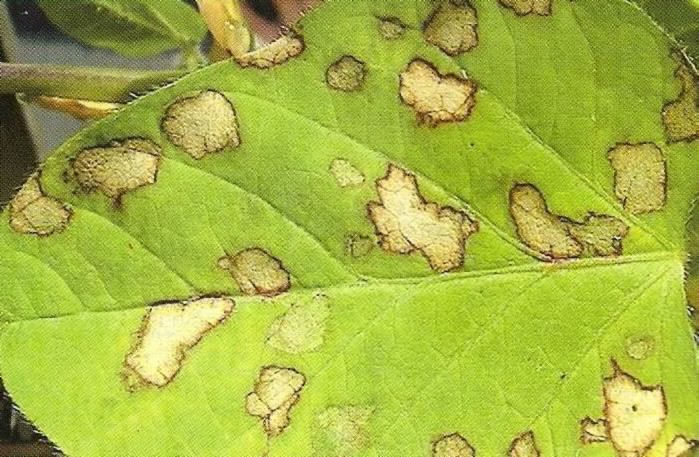

Rhubarb ascochitis affects both the rhizome and the stem with leaves
Powdery mildew
The well-known and annoying powdery mildew is similar to the white velvet covering the leaves of rhubarb. The disease progresses in early summer, slowing down the growth of the entire plant. The affected parts darken and die off, rhubarb does not throw out flower arrows, very often a weakened plant does not overwinter.
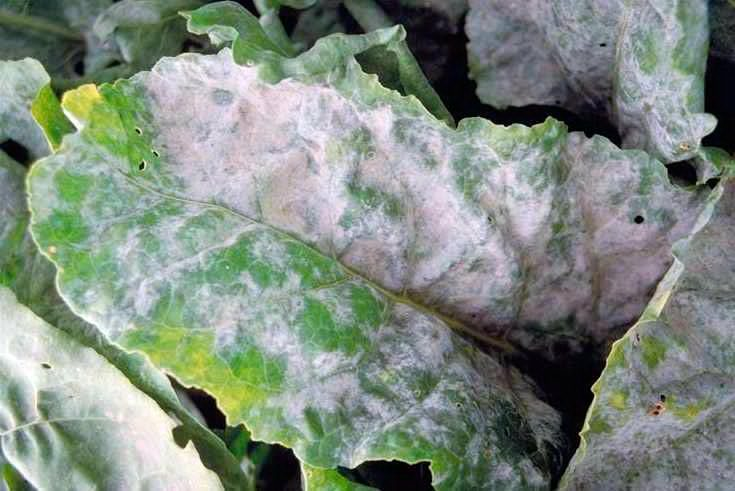

Powdery mildew on rhubarb develops in early summer
Rust
Rust is characterized by the formation of pustules containing "rusty" fungal spores. The pustules crack and spill them onto the ground. The disease weakens the growth of rhubarb, disrupts metabolic processes in parts of the plant.
Rust impairs the growth of rhubarb
Pests
Rhubarb is an early plant, therefore it is attacked by many pests.
Rhubarb weevil
The rhubarb weevil is adapted to any climatic conditions, therefore it appears wherever rhubarb is grown. The body of adult beetles is up to 6 mm long and is covered with gray or brown scales on top, small elytra are located on the sides. Females of weevils lay eggs on stalks of sorrel and buckwheat, which they begin to feed on in early spring. Later, pests move to rhubarb. Therefore, buckwheat and sorrel are not planted next to this crop.
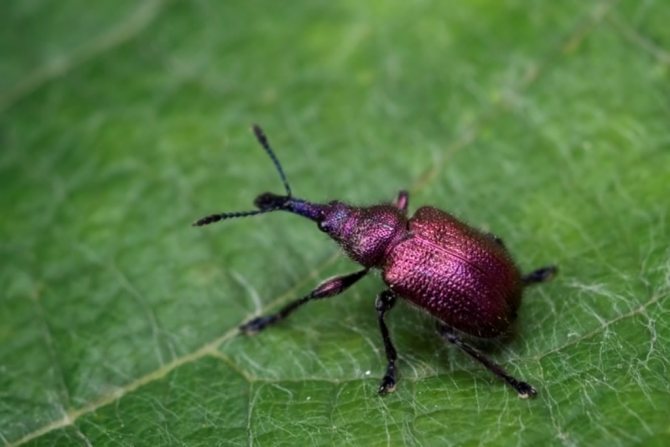

The female rhubarb weevil lays eggs on buckwheat and sorrel, so rhubarb cannot be planted with these plants.
Caterpillars of the potato scoop
Rhubarb and caterpillars of the potato scoop, which appear in spring from the eggs laid by it on the weeds, annoy. Caterpillars feed on the flesh of rhubarb stalks and leaves, damaging more and more stems. The best way to control them is to kill all the weeds in the rhubarb beds. If there are too many butterflies, light traps are installed for them, under which containers with molasses are laid out. To do this, 50 g of yeast is fermented in 1 liter of water and stirred with molasses in a ratio of 3: 1. Thus, by catching butterflies, the number of egg-laying is also reduced.
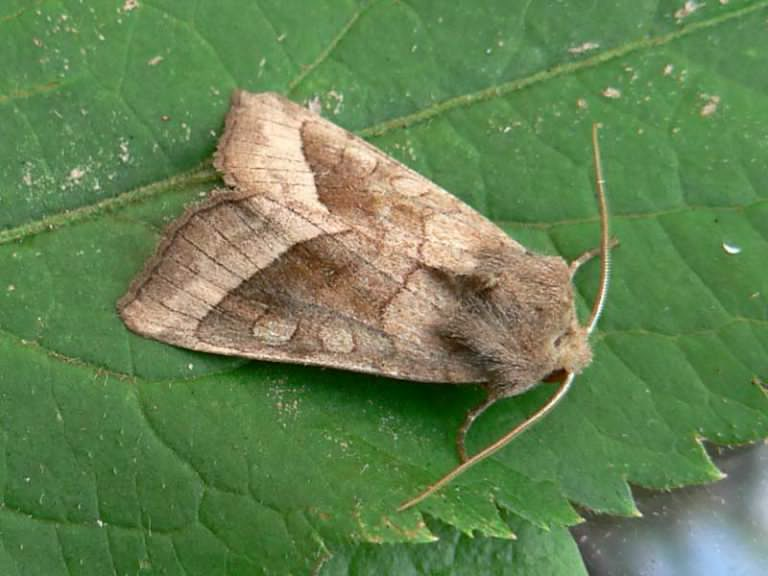

Caterpillars of the potato scoop feed on the flesh of the rhubarb stem and leaves
Rhubarb bug
The rhubarb bug is easy to spot in flight by its bright diamond-shaped abdomen. From above, the insect has a brown color, and on its head there are long red antennae-antennae. It feeds on rhubarb leaf juice. The consequence of its presence is brown spots on the leaves. The pest especially likes young plants. Its difference from other "fellows" is the absence of a disgusting smell. Bedbugs fly from one plant to another, causing great harm to rhubarb plantations.
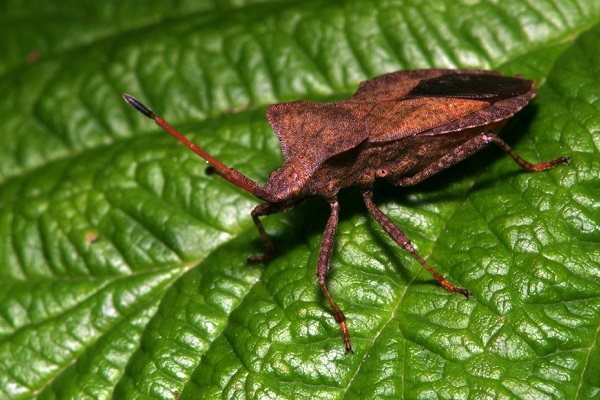

The rhubarb bug feeds on rhubarb leaves, weakening the plant
Treatment and prevention
For preventive purposes:
- destroy diseased and insect-damaged rhubarb leaves;
- weeds are removed in time;
- loosening the soil several times per season;
- watered regularly;
- for the winter, be sure to dig up the soil around the plants on the bayonet of a shovel.
For treatment against diseases and pests, the following are used:
- one percent Bordeaux mixture - to combat fungal diseases;
- 40% phosphamide at the end of the growing season - for the prevention of lesions by rhubarb weevil.
Video: preparing Bordeaux mixture
The use of chemicals for processing rhubarb is not recommended in order to avoid poisoning with toxic substances that rhubarb can accumulate in large quantities.
If chemicals are indispensable, they are used with great care. The least harm is brought by treatment with pesticides in areas with annual seedlings. On adult plants, they are used only at the very end of the season, after the last harvest, in October or November.
How to do rhubarb breeding?
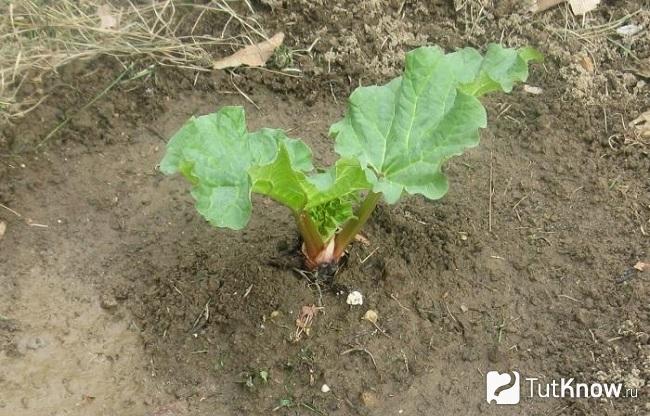

Most often, this representative of the flora can be propagated by seeds or using the vegetative method (parts of the rhizome - delenki).
- Propagation of rhubarb using seeds.
To use the seed method, you must first grow seedlings. At the same time, it is noted that approximately 75% of the emerged seedlings will lose their varietal characteristics, and they will not be as productive. Such plants will be able to get a harvest only in the third year, from the moment of sowing. If a decision is made to deal with seedlings, then it is recommended to form a school (seedling bed), where the seed is sown. Freshly harvested rhubarb seeds are used.Sowing is carried out as in the fall, even on frozen soil or in spring. In the latter case, a preliminary monthly stratification is required - the seeds are kept for 30 days on the lower shelf of the refrigerator at a temperature of 0-5 degrees Celsius. Rhubarb seeds are planted to a depth of no more than 2–3 cm. Usually, after 15–20 days, the first sprouts of rhubarb can be seen. They should be thinned out. When 1-2 years have passed from the moment of planting, then transplantation to a permanent place in the garden is necessary. Such manipulation is carried out in early spring or early September. - Propagation of rhubarb by parts of rhizomes.
This method is better because the harvest will be able to be harvested in the second year of cultivation. To do this, it is necessary in the spring or early September to select a completely healthy and well-developed plant that has reached 3-4 years of age. It is removed from the soil, and the rhizome is divided into parts with a sharpened knife or shovel. Each of the divisions should have 1–2 sufficiently developed buds and a pair of thickened root processes. All sections must be immediately sprinkled with crushed charcoal for disinfection. After that, the rhubarb cuttings are placed in the shade to dry. This will save the seedlings in the future from decay after planting in the ground. Landing is carried out according to the above rules.
Growing and care
Rhubarb is classified as unpretentious, undemanding to light and cold-resistant plants. But for a plentiful and tasty harvest, some growing conditions are needed:
- loosening the soil in the aisles,
- timely weeding,
- fertilizing with fertilizers,
- abundant watering,
- removal of arrows of inflorescences,
- if necessary, fight against diseases and pests.
The plant tolerates shade well, but grows better in open, sunny areas and has a more decorative appearance of leaves and a delicate taste of petioles. This culture requires especially good illumination when growing seedlings from seeds.
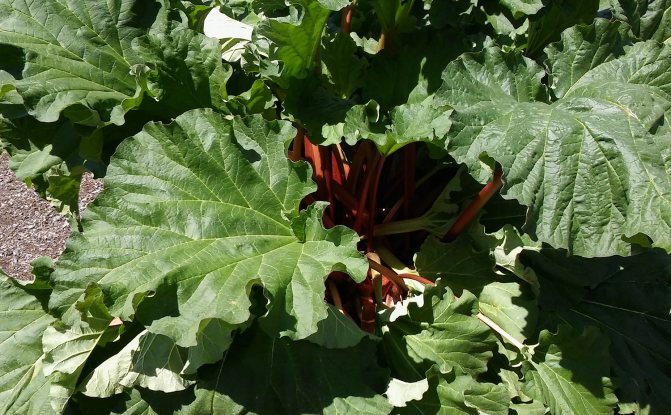

Rhubarb grows better in open, sunny areas
At low humidity and high temperatures, the quality of the petioles is significantly reduced.
Planting methods
Rhubarb is planted by seedlings or by sowing seeds directly into the ground. The landing site is prepared in advance: they dig up the site, add humus at the rate of 10 kg / m2. The soil should be fairly moist and aerated, sand is added on heavy soils. The fact that rhubarb can grow in one place for more than 10 years is also taken into account, while it grows strongly, therefore, an adult plant needs an area of at least 1 m2.
Sowing with seeds in open ground
Plant seeds can be sown directly into open ground. Since they are not afraid of frost, this can be done in late autumn (early-mid November).
- The seeds are laid out in shallow grooves to a depth of 1.5 cm and at a distance of 20-25 cm from each other.
- In the frozen soil, they will undergo a process of natural stratification and in April they will give amicable shoots.
- In the fall, grown plants are transplanted to the right place.
You can immediately sow seeds in a permanent place so as not to transplant the seedlings, while the embedding depth is increased to 3 cm, and the distance between the seedlings is made at once 70-100 cm.
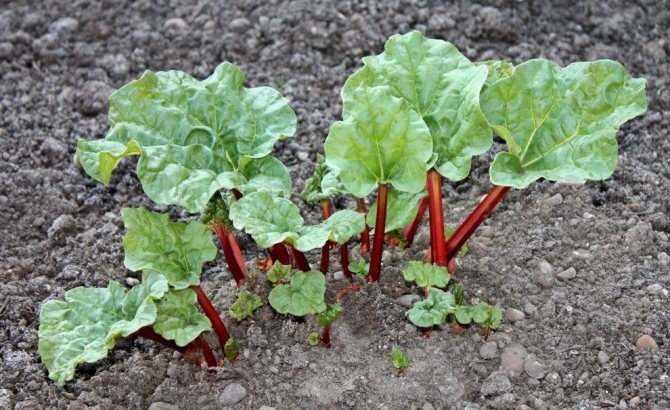

This is how seedlings from winter sowing seeds, ready for autumn planting, look like
Growing seedlings
Spring sowing for seedlings is carried out in late February or early March.
- The seeds are soaked for 2 days in water or a growth regulator to improve germination, after having prostrated them in the refrigerator for 2 months.
- After the seeds swell and sprouts about 2 cm long appear, they are dried and planted in prepared moist soil with a distance between rows of 20-25 cm.
- After the appearance of the leaves, the seedlings are thinned out.
- In May, when the seedlings reach a height of 30 cm, have 3-4 formed leaves and a red coloration of the lower part of the petioles, they are planted in a permanent place according to the 1 × 1 m scheme.
- If planting is too late, too large leaves must be removed.
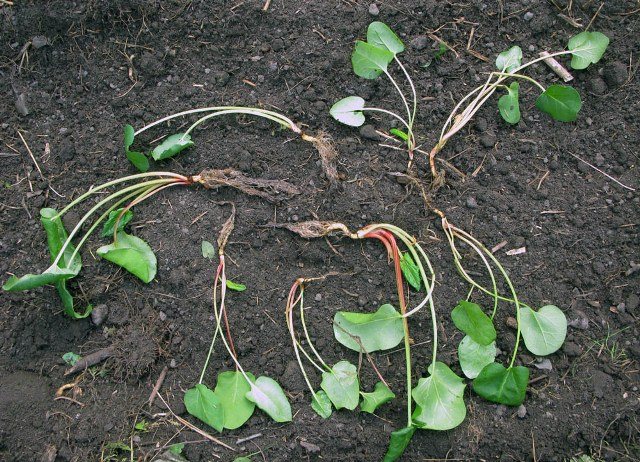

By the end of May, rhubarb seedlings reach a height of 30 cm, have 3-4 formed leaves and a red coloration of the lower part of the petioles
Sowing with seeds has some drawbacks: rhubarb seeds do not germinate well, the plant may not transfer species and varietal properties. Therefore, rhubarb is more often propagated by dividing the rhizome.
Propagation of rhubarb by dividing the rhizome
The rhizome of a 4–5-year-old bush is divided into several parts so that each part has 3–4 buds, and planted in such a way that the apical bud (the rudiment of a new shoot), after the soil subsides, remains at the level of the soil surface.


For division, take a rhubarb bush no older than five years of age
The soil around the clearing is compacted. At low soil moisture, when planting rhubarb, watering is done at the root (2 liters per share). This method allows you to preserve the variety and quickly get a harvest. The divisions take root much better than seedlings.
Watering
Rhubarb is a moisture-loving plant that requires a soil moisture capacity of at least 80%. This fact is easy to explain: the huge leaves of rhubarb have a large evaporating surface, and the rhizome is close to the soil surface.
The more often the plant is watered, the larger, juicier and more tender its petioles will be. Of course, first of all, the frequency of watering depends on the weather conditions. In dry times, you should drink rhubarb at least 2 times a week. At the beginning of the growing season and during harvesting, watering should be increased up to 3-4 times a week, using 10 liters of water per 1 m2.
To make the leaves grow quickly, flower arrows are cut on the rhubarb. After each watering, light loosening of the soil is done and weeds are removed.


At the beginning of the season, young rhubarb plants especially need watering.
Top dressing
Rhubarb loves fertile soils, therefore it grows well on humus, loamy and cultivated clay soils, rich in nutrients.
An indispensable condition for caring for a plant is annual feeding:
- Organic fertilizers, as a rule, are applied in the fall in the form of rotted manure, humus, plant residues at the rate of 1-2 buckets per 1 m2.
- In the spring, the soil is filled with mineral water: 30 g of carbamide and potassium sulfate, 60 g of superphosphate per 1 m2 of plot are added.
- Fertilizers are carefully spread around the root zone or sown seeds.
- For an accelerated flow of top dressing into the soil, watering is performed.
There are often recommendations to apply complex mineral fertilizers after each collection of petioles. But nevertheless, it is better to take care of the further condition of the soil and fertilize it with plant infusions: for example, infusion of nettle or mullein.


Nettle infusion is used as a fertilizer for rhubarb
Soil mulching
The first mulching of rhubarb is carried out immediately after planting seedlings or cuttings in the ground, as soon as they take root well. To do this, the soil around the plants is moistened, loosened and mulching material is spread over the surface. In this case, the leaf rosette of the rhubarb is left open.
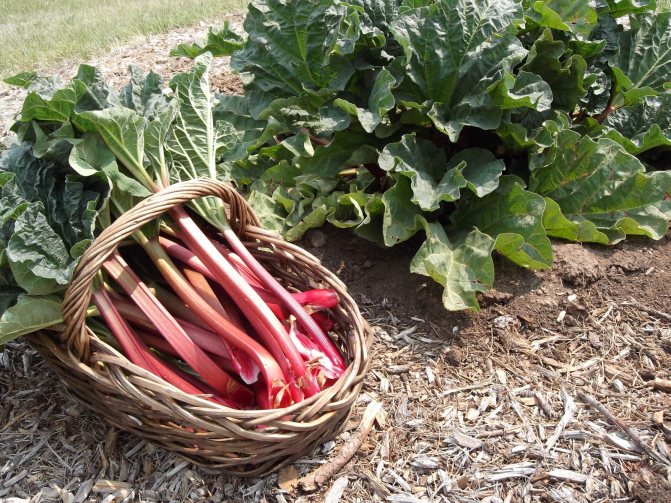

When mulching rhubarb, the leaf outlet is left open.
Plant residues, fallen leaves are used as mulch. Thanks to mulching, the soil remains moist and keeps warm. In addition, the growth of weeds around the rhubarb is suppressed.
The second mulching is done in the fall after the leaves die off. Now, on the contrary, a well-covered and covered rosette will be the key to a successful wintering of the plant. Experienced gardeners recommend protecting the plantings of rhubarb with a low wire mesh (25-30 cm) and completely filling them with fallen leaves, tamping it well. Another advantage of this method of mulching is that in the spring, leaf humus will serve as a good organic fertilizer.
In the same way, mulching is carried out every year in the spring and late autumn.
The straw, taken as mulch, mineralizes over time, increasing the microbiological activity of the soil, which leads to a decrease in the nitrogen content in it.This mulching material is not suitable for rhubarb!
Rhubarb harvest
With proper care and proper planting, rhubarb builds its leaf mass until fall, but it is a seasonal product. Petioles of the earliest varieties are eaten from the beginning of regrowth to mid-June, late varieties can be used until mid-July. Then they become sinewy, tough, tasteless, moreover, organic acids accumulate in them.


Rhubarb lovers can harvest stalks in the form of marmalade, compote, marinade, jam.
Harvesting: how to prune rhubarb correctly
In the second year after planting rhubarb, lovers of the original and useful plant can only harvest the long-awaited harvest from the early varieties. The technical maturity of petioles in late varieties occurs only in the third or fourth year.
Usually, pruning begins in late May or early June. In a two-year-old rhubarb, a maximum of 3 petioles are broken out, stretching the collection up to a month, so that weakened plants do not reduce the yield in the future.
When pruning, they adhere to some rules:
- only soft, young and juicy petioles are harvested, their consumer ripeness is determined by a length of at least 25 cm and a thickness of at least 1.5 cm;
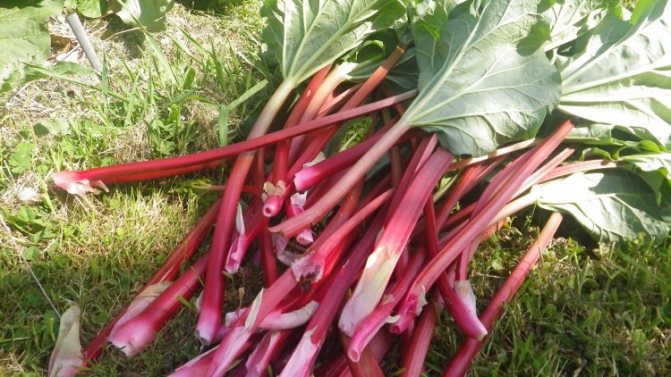

Suitable for harvesting young rhubarb stalks 25 cm long and 1.5 cm thick - the petioles are carefully broken off at the root base, smoothly twisting and pulling up (do not cut or tear off), while it is important not to touch the buds in the leaf axils;
- the foil at the base of the petiole is not removed, but the leaf is cut so that a small part of it remains on the petiole - this is done so that the petiole does not fade quickly and is stored longer;
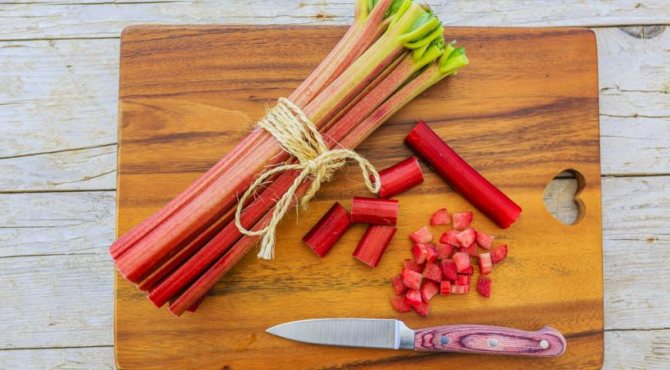

When cutting the petioles of rhubarb, a small part of the leaves is left on them so that the petioles are stored longer - the plant is left with 4 leaves, which is necessary for growth and future harvest;
- the flowering arrows of rhubarb are immediately removed so that harmful substances do not accumulate in the plant and the taste of the petioles themselves is softer; at the same time, the duration of the harvest also increases;
- at the time of flowering (from late June to mid-July), young petioles do not develop on rhubarb, and oxalic acid accumulates in old and coarse ones, so they refrain from harvesting during this period. Only after the young leaves grow back, the collection continues, ending the season at the end of September, because the weakened plants must have time to get stronger, and their rhizomes must accumulate nutrients.
One five-year-old rhubarb bush is capable of producing up to 6 kg of petioles, which reach up to 80 cm in length.

